Table of Content
Table of Content
Quick Summary: This comprehensive guide explores various facets of software development outsourcing including its benefits, challenges, financial models, and proven strategies. It aims to provide insights on effectively leveraging outsourcing to access global talent and innovative solutions while optimizing costs and focusing on core competencies.
Using software development outsourcing is like unlocking a treasure trove of resources and expertise for businesses. Outsourcing not only offers access to a global pool of talent but also provides cost-effective solutions for companies of all sizes.
It enables businesses to focus on their core competencies while tapping into the expertise of specialized software developers. This guide aims to explore the various facets of software development outsourcing, including its benefits, challenges, and best practices.
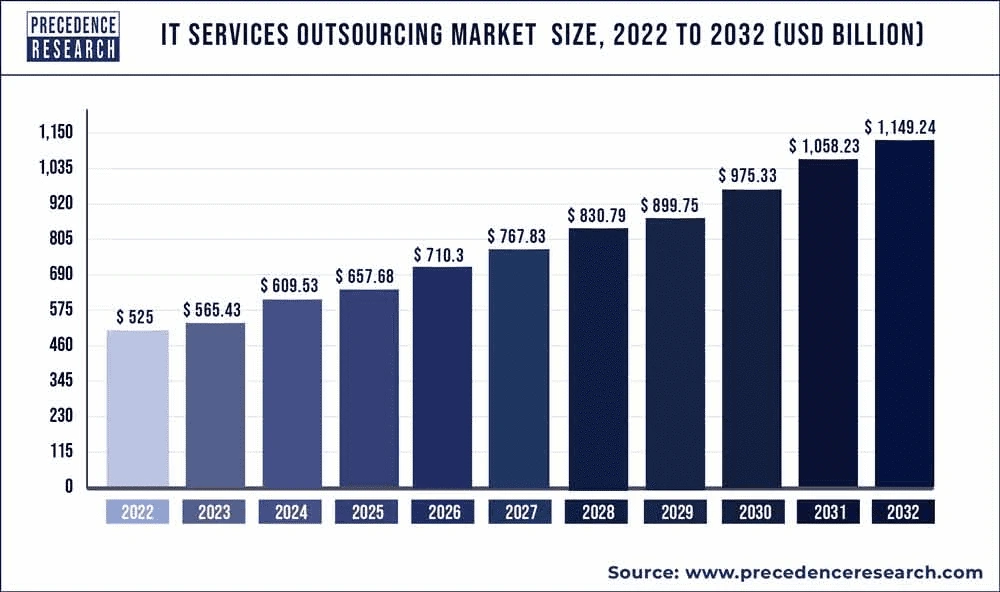
The significance of outsourcing in the tech industry is underscored by its market growth. The global IT services outsourcing market is expected to hit around USD 1.14 trillion by 2032, growing at a compound annual growth rate (CAGR) of 8.2% from 2023 to 2032.
In this blog, we’ll explore the dynamics of software development outsourcing, providing insights and strategies for harnessing its full potential.
Software outsourcing is a strategic move for many companies. It involves hiring external entities to manage various technology-related tasks. By doing so, businesses can focus on core competencies while external experts handle specific software needs.
By going for software development outsourcing, firms collaborate with external partners to enhance their capabilities. This collaboration significantly optimizes the development lifecycle of software, bringing in specialized skills and advanced technologies.
Outsourcing is not just about cost-saving; it’s also about accessing global talent and innovative solutions. It offers scalability and flexibility, adapting to the evolving needs of the business.
Software outsourcing encompasses diverse approaches, each with distinct advantages. Here are the varied types of software development outsourcing models, offering tailored solutions for business needs.

Onshore outsourcing refers to partnering with companies within the same country. This alignment offers easier coordination and cultural compatibility. Businesses opt for onshore outsourcing to ensure better communication and collaboration.
It is ideal for projects requiring frequent interaction and on-site visits. In the context of software development outsourcing, onshore partners provide easy access to local market insights.
While typically more expensive, the benefits of shared language and time zones are significant. Onshore outsourcing is often preferred for complex, collaborative projects in software development. It ensures compliance with local regulations and standards, making it a reliable option.
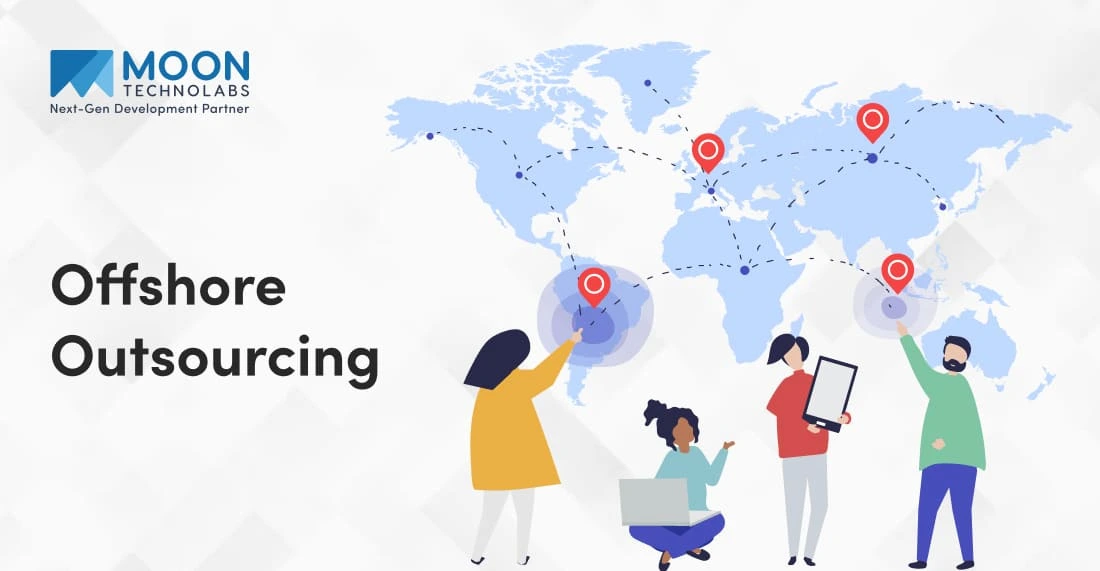
Offshore outsourcing involves hiring development companies from different countries, often with significant time zone differences. This model is popular for its cost-effectiveness and access to a vast talent pool.
Offshore outsourcing allows businesses to leverage global expertise for competitive advantage. It’s particularly effective for large-scale, labor-intensive tasks in outsourcing software development.
While cost savings are substantial, challenges include cultural differences and communication barriers. Companies must manage these aspects effectively to benefit from offshore outsourcing.
It’s a strategic choice for businesses seeking to expand their capabilities without substantial investment. Offshore outsourcing can lead to innovative solutions and enhanced efficiency.
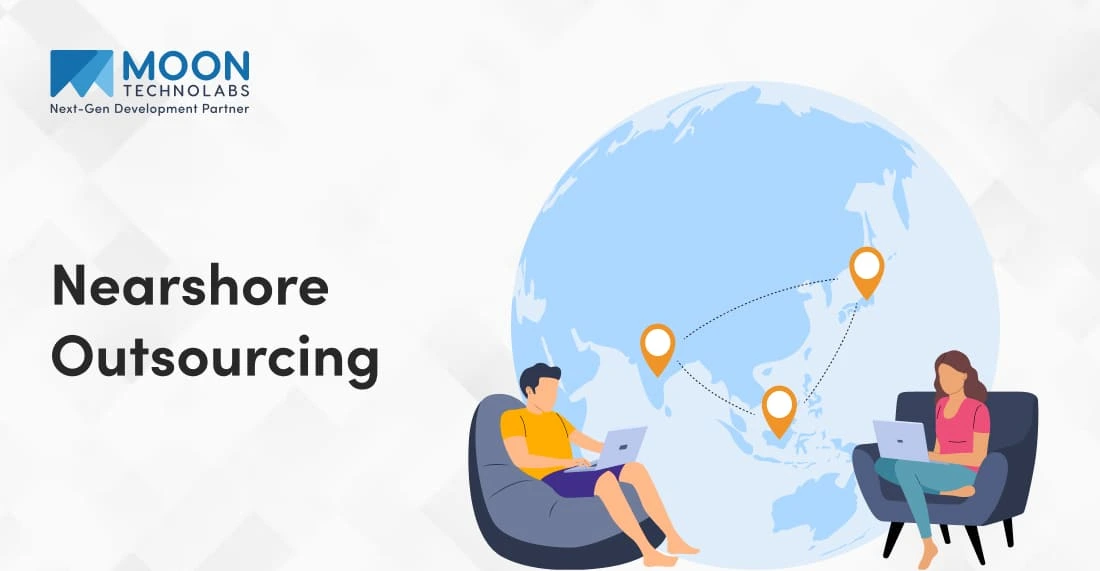
Partnering with businesses in adjacent or neighboring nations is known as “nearshore outsourcing.” This strategy combines cost-effectiveness with similarity in culture and time zone.
Businesses often choose nearshore outsourcing for better alignment in working hours and easier travel for meetings. It offers a balanced mix of affordability and convenient collaboration.
In software development outsourcing, nearshore options provide a middle ground between onshore and offshore models. They enable efficient communication and cultural affinity, crucial for agile software projects.
Nearshore outsourcing is particularly beneficial for projects requiring regular, real-time collaboration. It offers a synergy of cost savings, proximity, and cultural understanding, enhancing the overall outsourcing experience.

Global outsourcing is a comprehensive approach, embracing a wide spectrum of skills and resources from around the world. Unlike offshore outsourcing, which primarily focuses on cost advantages and labor-intensive tasks, global outsourcing is about strategically leveraging diverse international expertise for enhanced innovation and problem-solving.
This model facilitates collaboration with partners from multiple countries, integrating a variety of perspectives and methodologies. Outsourcing software developers means not just tapping into different talent pools but also blending various technological strengths and cultural insights.
This holistic approach leads to a more robust and creative development process. It’s ideal for projects that require a blend of specialized skills from different parts of the world.
Understanding these outsourcing types helps companies make informed decisions. Each type offers unique benefits tailored to different project needs.
Outsourcing in software development has transformed how businesses approach project management. It offers accessibility to specialized talent and a high level of flexibility.
Here are the key benefits of software development outsourcing.
Cost savings are a primary benefit of software development outsourcing. Outsourcing reduces operational and labor costs significantly. Businesses can allocate these savings to other strategic areas, enhancing overall efficiency.
Thus helping reduce the overall software development cost. This financial flexibility is crucial for startups and established firms alike, making outsourcing a cost-effective solution.
Access to global talent is a major advantage for businesses that outsource software development. It opens doors to world-class expertise and specialized skills. This global pool of talent brings diverse perspectives and innovative approaches to projects.
Companies benefit from the latest technological trends and practices. Such access enhances the quality of software solutions, driving business growth.
Software development outsourcing allows businesses to concentrate on their core competencies. By delegating software projects, companies free up internal resources. This focus leads to improved efficiency in their primary business areas.
Outsourcing also provides access to specialized skills, ensuring high-quality software development. Companies can thus streamline their operations and enhance their market offerings.
Scalability is a key benefit of why businesses outsource software development. It provides the flexibility to scale teams up or down based on project needs.
This adaptability is vital in the fast-paced tech environment. Outsourcing allows for quick adjustment to changing market demands. It also ensures businesses remain agile and responsive without the burden of permanent staffing.
Faster time-to-market is achievable with software development outsourcing. Outsourcing accelerates the development process by leveraging specialized skills and efficient workflows.
This speed is crucial in a competitive market. It enables businesses to launch products swiftly, staying ahead of the curve. Faster deployment translates to quicker returns and a competitive advantage.
Outsourcing offers a strategic edge in software development. It enables businesses to innovate while optimizing costs and resources.
Discover how software development outsourcing can revolutionize your business’s efficiency and growth.
Learn More
Outsourcing offers solutions to a range of challenges that modern businesses frequently encounter. Here are the six common scenarios when the need for outsourcing, especially in software development, becomes apparent and essential.
When in-house teams lack specific expertise, software development outsourcing becomes essential. Outsourcing provides access to specialized skills and knowledge that may be absent internally.
It bridges the gap in expertise, ensuring high-quality project outcomes. This scenario is common for companies venturing into new technological areas.
Resource constraints often lead companies to seek external help. A software development outsourcing company can offer the necessary resources without the overhead of hiring full-time staff.
Outsourcing in this scenario allows for efficient resource management. It’s ideal for businesses needing to scale up their development efforts temporarily.
Cost efficiency is a major factor driving outsourcing. When achieving cost savings is a priority, software development outsourcing offers a viable solution.
It reduces operational and labor costs, enabling businesses to invest more in growth and innovation. This approach is especially beneficial for startups and small businesses.
Faster project delivery is crucial in a competitive market. Outsourcing to a specialized software development company can expedite the development process.
It brings in efficiency and expertise, leading to quicker turnaround times. This is particularly important when meeting tight deadlines or launching products in a time-sensitive market.
To maintain focus on core activities, businesses often outsource software development. This approach allows companies to concentrate on their primary business areas without the distraction of complex software projects.
Outsourcing frees up internal resources, enhancing overall productivity and focus on strategic goals.
Access to specific technologies is another scenario where outsourcing is beneficial. A software development company specializing in certain technologies can provide expertise that may not be available in-house.
This is essential for projects requiring advanced or niche technology skills. Outsourcing in this context accelerates project development and ensures technological proficiency.
Recognizing these scenarios can help businesses strategically decide when to outsource. It ensures that outsourcing is leveraged effectively for optimal results and growth.
Software outsourcing is not a one-size-fits-all solution; it varies based on specific business needs. Here are the basic models of outsourcing, each with its unique characteristics and applications. Understanding these models helps businesses choose the most suitable approach for their projects.
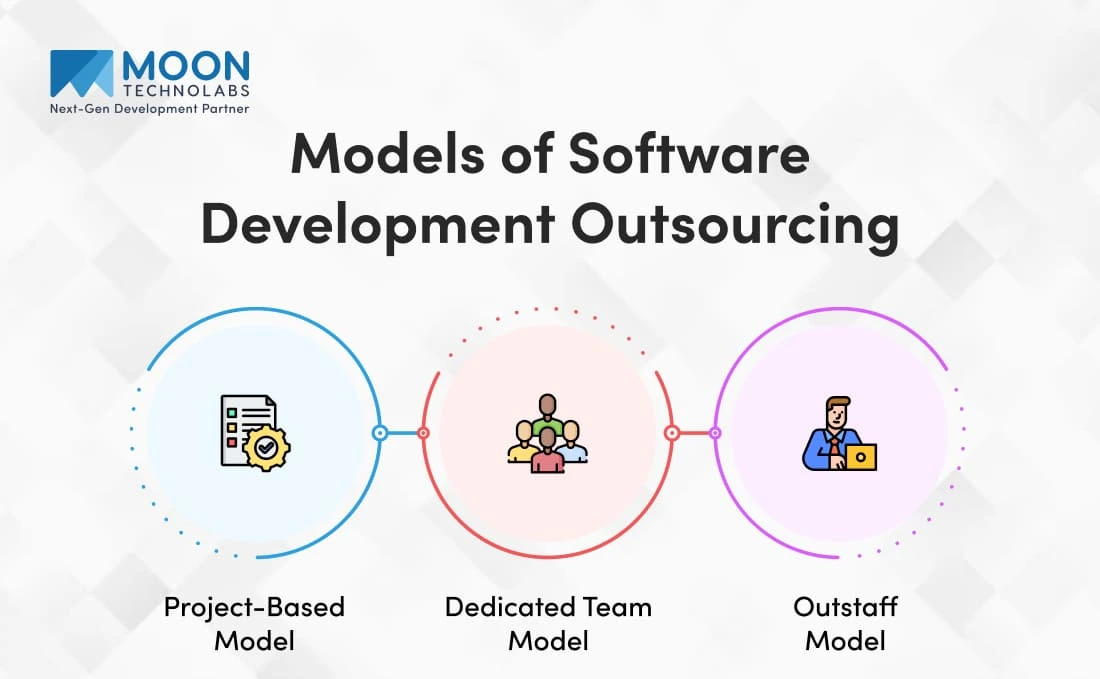
The project-based model in software development outsourcing is ideal for discrete, time-bound tasks. It offers a structured framework, ensuring that projects are completed efficiently and effectively.
This model is characterized by its well-defined scope, fixed timeline, and pre-set budget, providing clear expectations and minimizing risks.
It’s particularly advantageous for specialized projects that require niche expertise. It is also good for one-off tasks that don’t necessitate long-term engagement.
Businesses benefit from this model through its clear deliverables and predictable costs. It allows them to focus on core operations while the outsourced team handles specific project requirements.
Pros: |
Cons: |
| Fixed scope and budget prevent cost overruns. | Limited flexibility for scope changes. |
| Ideal for short-term, specialized projects. | High dependence on initial requirement accuracy. |
| Simplifies project management with clear objectives. | Not suitable for long-term or evolving projects. |
The dedicated team model represents a strategic partnership in outsourcing. A software development company allocates a team exclusively for the client’s projects, fostering deep collaboration.
This model excels in long-term projects that require ongoing development and a nuanced understanding of business goals. It is characterized by a high level of integration and alignment with the client’s internal team, enhancing project coherence and efficiency.
Ideal for complex, evolving projects, this approach provides continuity, stability, and dedicated support. It allows for seamless scalability and adaptability, accommodating changing requirements with ease. This model is a perfect fit for businesses seeking dedicated, long-term software development support.
Pros: |
Cons: |
| Better integration with in-house teams and company culture. | Generally higher costs due to long-term commitment. |
| Greater flexibility for project evolution and changes. | Requires time for the team to align with company processes. |
| Deep understanding of long-term project objectives. | Potential challenges in remote team management and communication. |
Nearshore software development outsourcing involves partnering with companies in neighboring or nearby countries. This model offers a balance between cost and convenience, blending the benefits of both offshore and onshore models.
Nearshore outsourcing is ideal for businesses seeking geographical and cultural proximity to their outsourcing partners. It facilitates better communication and collaboration due to similar time zones and cultural understanding.
This model is particularly beneficial for projects that require regular interaction and a high degree of coordination. It provides the advantages of cost efficiency while maintaining a level of convenience and accessibility in operations and management.
Pros: |
Cons: |
| Cultural and time zone alignment facilitates better communication. | Slightly higher costs than offshore outsourcing. |
| Cost-effective compared to onshore, yet offers similar conveniences. | Limited talent pool compared to global outsourcing. |
| Easier travel and coordination for in-person meetings. | Potential language barriers, depending on the region. |
Onshore outsourcing involves hiring a software development company within the same country. This model ensures maximum alignment in terms of language, culture, and business practices.
Onshore outsourcing is particularly suitable for projects that require close collaboration, frequent face-to-face interactions, and a deep understanding of local market nuances.
It’s ideal for companies prioritizing ease of communication and quick turnaround times. Onshore outsourcing provides the comfort of shared legal systems and regulations, making it a preferred choice for projects needing strict compliance and security.
Pros: |
Cons: |
| Seamless communication with no language barriers. | Higher costs compared to nearshore and offshore models. |
| Alignment in legal and business practices. | Limited global talent pool access. |
| Easy collaboration with similar working hours and cultures. | May not provide the same level of cost savings as other models. |
Offshore software development outsourcing involves partnering with companies in distant countries, often across continents. This model is highly sought-after for its significant cost savings and access to a vast global talent pool.
It allows businesses to leverage specialized expertise and innovative technologies available in different parts of the world. Offshore outsourcing is particularly effective for large-scale projects where cost efficiency is paramount.
Despite the challenges posed by time zone differences and cultural variances, this model offers the advantage of round-the-clock development, speeding up the project lifecycle and enhancing productivity.
Pros: |
Cons: |
| Substantial cost savings compared to onshore and nearshore options. | Potential communication and cultural barriers. |
| Access to a diverse, global talent pool for specialized expertise. | Challenges in coordinating across significantly different time zones. |
| Continuous development cycle due to varying time zones. | Dependence on remote management and collaboration tools. |
Each outsourcing model offers distinct benefits and suits different project requirements. Selecting the right model is crucial for the success of any outsourcing venture.
Learn the pros and cons of each to make informed decisions.
Talk To Us
Financial models in software outsourcing are pivotal in defining the relationship between a company and its outsourcing partner. Here are the various models that businesses can choose from, each with its unique characteristics and benefits.
The time and materials (T&M) model in software development outsourcing is flexible and adaptable. It’s suitable for companies with evolving project scopes where requirements change frequently.
This model allows businesses to pay for the actual work done, based on time and materials used. It’s ideal for projects where it’s challenging to estimate the full scope of work in advance.
Pros: |
Cons: |
| High flexibility for changing project scopes. | This can lead to higher costs if not carefully managed. |
| Payment aligns with the actual work done and resources used. | Requires diligent tracking of time and materials. |
The fixed price model in software development outsourcing is ideal for companies with well-defined project requirements and limited flexibility. This model suits projects with a clear scope, predictable timelines, and a set budget.
Companies that prefer stability and predictability in costs, and those working on smaller or less complex projects, often opt for this model.
Pros: |
Cons: |
| Predictable costs and reduced financial risk. | Less flexibility to accommodate project scope changes. |
| Clear scope and deliverables established from the start. | Potential for quality compromise to stay within budget. |
The milestone-based model is suitable for companies seeking structured progress tracking. This approach is ideal for larger projects with clearly defined stages or deliverables.
It provides a balance between flexibility and financial control. Thus making it a good choice for projects where outcomes can be segmented into distinct phases or milestones.
Pros: |
Cons: |
| Allows for close monitoring of project progress and deliverables. | Requires detailed upfront planning to define milestones. |
| Payments are tied to the completion of specific milestones, ensuring accountability. | This can lead to delays if milestones are not met on time. |
The dedicated team model is best suited for companies with long-term or ongoing projects. It’s ideal for businesses needing continuous development, support, and a team that aligns closely with their internal processes.
Companies looking for deep integration of outsourced personnel into their existing corporate culture and workflows often choose this model.
Pros: |
Cons: |
| Ensures deep integration and alignment with company culture and processes. | Typically involves higher costs due to long-term commitment. |
| Provides continuous support and development for long-term projects. | Requires time and effort for effective team integration and management. |
The outcome-based or success-fee model in software development outsourcing suits companies targeting specific, measurable outcomes. This model is ideal for businesses focused on results and willing to share risks and rewards with their outsourcing partner.
It motivates the outsourcing partner to focus on delivering tangible, successful outcomes, aligning their interests closely with those of the client.
Pros: |
Cons: |
| Aligns the outsourcing partner’s incentives with project success. | Can involve higher costs if success metrics are achieved. |
| Encourages focus on results and quality of work. | Requires clear definition and agreement on success criteria. |
Choosing the appropriate financial model is essential for the success of any software outsourcing venture. It ensures the alignment of business goals with financial strategies, optimizing both cost and project outcomes.
Software development outsourcing is a complex process that demands strategic planning and execution. Here are the key strategies to ensure success and adherence to software development best practices.
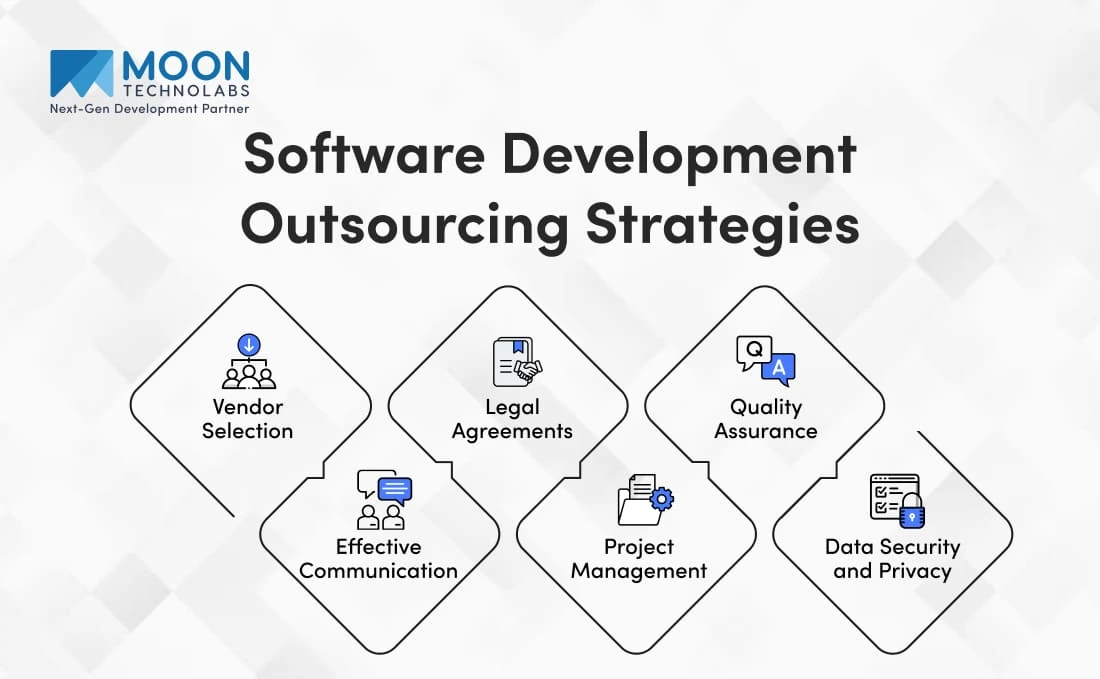
Choosing the right vendor is critical in software development outsourcing. It involves assessing potential partners’ technical expertise, experience, and compatibility with your business goals.
Research and due diligence are essential to understand a vendor’s track record and client feedback. Prioritize vendors who have proven experience in your industry or with similar projects.
Assess their technology stack, development methodologies, and project management capabilities. A good fit is not just about technical skills, but also about cultural alignment and communication style. Establishing clear criteria for selection helps in making an informed decision.
Effective communication is the backbone of successful software development outsourcing. Establishing clear, consistent, and open channels of communication ensures that both parties are aligned throughout the project.
Regular meetings, detailed reporting, and accessible contact points are essential. Use collaborative tools to facilitate real-time updates and feedback.
It’s important to establish a communication protocol that includes response times, escalation paths, and contact persons. Encourage transparency and openness in discussions to address challenges promptly.
Effective communication bridges the gap between different teams and cultures, playing a crucial role in the success of projects handled by a software development company.
Legal agreements form a crucial part of software development outsourcing. They protect both parties’ interests and set clear expectations. Essential components include scope of work, deliverables, timelines, confidentiality clauses, and payment terms.
Ensure that the agreement covers intellectual property rights, data security, and compliance with relevant laws. It’s important to involve legal experts in drafting and reviewing these agreements.
Clear, well-defined contracts prevent misunderstandings and disputes. They also provide a framework for resolving any issues that may arise during the project. A solid legal agreement is a safety net for both the client and the software development outsourcing company.
Effective project management involves planning, executing, and monitoring the project to ensure timely and quality delivery. Choose a development methodology that aligns with your project goals, whether it’s Agile, Scrum, or Waterfall.
It’s crucial to have a dedicated project manager from the software development company who serves as the main point of contact. They should possess strong leadership and communication skills to manage diverse teams.
Regular progress reviews, risk management, and adaptation to changes are key components. Effective project management ensures that the outsourced software development aligns with business objectives and is delivered within scope, time, and budget.
Quality assurance (QA) ensures that the software meets the required standards and functions as intended. Implement a comprehensive QA process that includes regular code reviews, testing, and performance evaluations.
The software development company should have a robust QA framework to detect and rectify issues early in the development cycle. Continuous testing, both automated and manual, is essential to maintain high quality.
This approach reduces bugs and improves user experience. QA should be integrated throughout the development process, not just at the end, to ensure the delivery of a high-quality product.
In software development outsourcing, data security and privacy are paramount. It’s essential to ensure that the software company you outsource to, adheres to strict data protection standards.
Implement measures such as encryption, secure access controls, and regular security audits. The outsourcing agreement should include clauses on data handling, confidentiality, and compliance with relevant data protection laws.
Regular training on data security for the outsourced team is crucial. These measures safeguard sensitive information from breaches and unauthorized access. Ensuring data security and privacy protects your business reputation and builds trust with customers and stakeholders.
Implementing these strategies in software development outsourcing ensures projects are completed efficiently and effectively. It aligns with software development best practices, leading to successful outcomes and long-term benefits for the business.
Benefit from our experience in optimizing software development outsourcing success.
Consult Our Experts
Successful software outsourcing demands a well-defined and strategic approach for optimal results. Here are the six proven steps of the software development lifecycle in outsourcing. These steps ensure a comprehensive and effective journey from initial planning to final execution.
Outsourcing in software development involves identifying your specific needs and objectives. This includes understanding the scope of the project, technical requirements, and business goals.
A clear definition of what you need helps in finding the right outsourcing partner. Determine if you require complete project development, specific expertise, or additional resources.
Assess your in-house capabilities to understand what gaps the outsourcing partner needs to fill. This step forms the foundation of your outsourcing strategy, ensuring that you seek services that align perfectly with your project requirements and business vision.
Vendor selection involves researching and evaluating potential outsourcing partners based on their expertise, experience, and past projects. Look for vendors who have a strong track record in your industry or with similar types of projects.
Evaluate their technical capabilities, communication skills, and project management methodologies. It’s also important to consider cultural compatibility and their ability to align with your business ethos. A thorough vetting process helps in selecting a vendor who can deliver quality results and foster a successful partnership.
Project planning is an essential phase in outsourcing in software development. This step includes defining project scope, timelines, and deliverables, and setting clear milestones.
Collaborate with your outsourcing partner to create a detailed project plan that outlines each stage of development. Ensure that the plan includes risk management strategies and contingency plans.
Effective planning also involves setting up communication protocols and establishing key performance indicators (KPIs) to measure progress. A well-structured project plan serves as a roadmap, guiding both your team and the outsourcing partner toward achieving the desired outcomes.
In the execution phase of the project, effective collaboration and communication with the outsourcing partner are essential. This is the stage where the plans and strategies formulated earlier are put into action.
As part of the software development outsourcing process, this phase involves the actual coding, development, and integration of software components. It’s crucial to maintain a constant flow of information and feedback between all parties involved.
Regular progress reviews and adjustments ensure that the project stays on track and aligns with the set objectives. Execution is all about turning the conceptualized ideas into a functional software product.
During the quality assurance phase of the software development lifecycle, the focus is on ensuring the software meets all quality standards and functional requirements. This involves systematic testing, bug fixing, and performance evaluation.
The goal is to identify any issues that might impede the software’s functionality or user experience. A rigorous QA process is key to delivering a reliable and efficient software product.
It’s a continuous process that should run parallel to the development phase, ensuring that any problems are promptly identified and resolved. Quality assurance is critical in building a product that not only meets but exceeds user expectations.
After the development and quality assurance stages, the delivery and evaluation phase commences in the software development outsourcing process. This is when the completed software is delivered to the client for deployment and use.
It’s a crucial time for evaluating the software against the initial goals and requirements. Feedback from users and stakeholders is gathered to assess the effectiveness of the software.
This phase is not just about delivering the final product but also about analyzing its impact, performance, and areas for improvement. Delivery and evaluation provide valuable insights for future projects and help in refining strategies for ongoing software development success.
Following these steps systematically enhances the efficiency and outcomes of the software development process. It leads to successful software outsourcing, aligning closely with business goals and quality standards.
Chief Technology Officers (CTOs) often face multifaceted challenges in software development. Outsourcing can offer solutions ranging from cost efficiency to accessing specialized skills.
Here is how outsourcing software development can address these challenges:
Communication barriers can significantly impact the success of software development projects. These issues often stem from cultural differences, language barriers, and time zone mismatches.
Establishing effective communication strategies is essential to overcome these challenges. Utilizing modern communication tools and setting regular meetings facilitate clear and continuous dialogue.
It’s important for the outsourcing team and the CTO’s internal team to establish a common language for communication and align on suitable times for interaction. This approach helps in bridging communication gaps, ensuring better understanding and collaboration, and leading to a more effective outsourcing process.
Ensuring quality assurance is a key challenge in software development outsourcing. It involves setting up rigorous testing processes and regular code reviews.
Establishing a comprehensive QA plan that includes automated and manual testing is crucial for maintaining high standards. The collaboration between the outsourcing partner and the CTO’s team is vital in defining and upholding quality benchmarks.
Continuous monitoring and adaptation of the QA process ensure the developed software meets the desired quality levels. Effective quality assurance practices are essential for delivering a reliable and user-centric product.
Security is a paramount concern in software development. CTOs must ensure their outsourcing partners adhere to strict data protection standards. This involves implementing robust security protocols like encryption and secure access controls.
Regular security audits and compliance checks are crucial for maintaining data integrity. Including specific confidentiality and data protection clauses in outsourcing agreements safeguards sensitive information.
By prioritizing these security measures, CTOs can mitigate risks, ensuring the integrity and trustworthiness of the software solutions developed through outsourcing. By choosing to outsource software development, CTOs can effectively navigate and overcome many of their prevalent challenges. It provides a strategic advantage in managing technology needs efficiently and innovatively.
Estimating the cost of software outsourcing requires a comprehensive understanding of various factors.
Start by defining the scope and complexity of the project, as these are primary cost drivers. Consider the level of expertise needed, as more complex projects require higher-skilled (and often more expensive) professionals. Evaluate the potential outsourcing destinations, as labor costs vary significantly between countries.
Factor in the duration of the project, remembering that longer projects generally incur higher costs. Don’t forget to account for additional expenses like communication tools, travel, or training, if necessary. It’s also prudent to set aside a contingency budget for unforeseen challenges or scope changes.
Finally, compare quotes from multiple vendors to ensure competitive pricing and value for money. This methodical approach helps in arriving at a realistic and accurate cost estimate for software outsourcing.
Moon Technolabs stands as a beacon in the realm of software development outsourcing, offering unparalleled expertise and innovative solutions. With a team of seasoned professionals, we specialize in transforming your software visions into reality.
Our approach is client-centric, ensuring that each project aligns with your specific needs and business goals. We pride ourselves on our ability to tackle complex challenges, delivering cutting-edge solutions that drive efficiency and growth.
At Moon Technolabs, we don’t just develop software; we build partnerships that foster success and innovation.
01
02
03
04
05
Submitting the form below will ensure a prompt response from us.